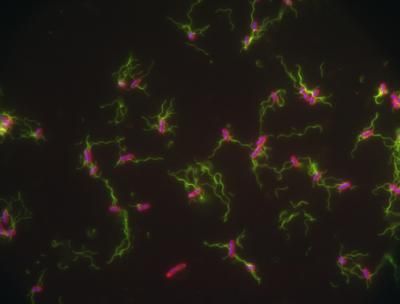Stanford scientists identify two molecules that affect brain plasticity in mice
You wouldn't want a car with no brakes. It turns out that the developing brain needs them, too. Researchers at the Stanford University School of medicine have identified a set of molecular brakes that stabilize the developing brain's circuitry. Moreover, experimentally removing those brakes in mice enhanced the animals' performance in a test of visual learning, suggesting a long-term path to therapeutic application.
In a study published in Neuron, Carla Shatz, PhD, professor of neurobiology and of biology, and her colleagues have implicated two members of a large family of proteins critical to immune function (collectively known as HLA molecules in humans and MHC1 molecules in mice) in brain development. Until recently, these immune-associated molecules were thought to play no role at all in the healthy brain.
In previous studies, Shatz and her co-investigators have shown that MHC molecules are found on the surfaces of nerve cells in the brain, and that they temper "synaptic plasticity": the ease with which synapses — the more than 100 trillion points of contact between nerve cells that determine brain circuitry — are strengthened, weakened, created or destroyed in response to experience. In one recent study, the Shatz group tied two specific members of the MHC1 family, called K and D, to the ability of circuits in a brain region responsible for motor learning to be refined by a learning experience.
This time, the scientists looked at vision processing in the brain. "We'd already found that K and D were located in brain regions we knew mattered: the visual cortex, and a relay station in the brain that sends its input to the visual cortex," said Shatz.
A good example of the "use it or lose it" manner in which experience-dependent circuit tuning shapes the brain is the ability of one eye to take over brain circuits that normally would be used by the other eye.
"Normally, your two eyes share vision-devoted brain circuits 50/50," Shatz said. "But when kids are born with a congenital cataract, or lose an eye — or in animal models where one eye is blocked — so that the brain's visual-information-processing machinery is no longer being used evenly by both eyes, the other eye doesn't just sit there. It takes over the machinery normally reserved for input from the other eye."
In order to map the roles of K and D in visual development, Shatz's group studied mice genetically engineered to lack these two molecules. They found that developmental circuit tuning was abnormal, she said. "The nerve input from the eyes was the same at the gross level — the major nerve tracts still went from the eye to the first visual relay system, and from there to the visual cortex. But the detailed connections within each structure had been altered. The adult patterning didn't develop normally."
In these K- and D-deficient mice, the capacity of a more-used eye to dominate visual information-processing circuitry is abnormal, and in a surprising way, said Shatz. "There's too much of it," she said. "If one eye stops functioning, the other eye takes over more than its fair share of the cortical machinery devoted to the brain's visual-information-processing territory."
In a test of visual performance, Shatz's team showed that the K- and D-deficient mice could see better through their remaining eye than could ordinary mice raised with a similarly blocked eye. "This suggests there's some kind of molecular brake on plasticity in the brain, and these molecules are involved in the braking system. Taking off the brake improved performance," she said.
Using a new method for localizing molecules in three-dimensional chunks of tissue (pioneered by co-author Stephen Smith, PhD, professor of molecular and cellular physiology and a member of the Stanford Cancer Center), Shatz's team was able to show that K and D are located at synapses. "We've placed them at the scene of the crime, right where circuit change happens," she said. "We think that in the brain they're pieces of a common braking-system pathway."
What's going on in the brain that needs a brake in the first place? Without both accelerators and brakes, any dynamic system — such as the brain, where connections change dramatically in response to whether they're being used — would become unstable, Shatz said. "Some of us think epilepsy, for example, could be a consequence of this process being not carefully controlled and regulated, and happening too easily."
That MHC molecules are also expressed on neurons has very large implications, because inflammation works through the immune system. Inflammation triggers the release of molecules called cytokines that change MHC1 levels on cells throughout the body, said Shatz. "If this process also changes MCH1 levels on cells in the brain, could that alter the circuit-tuning process enough to make a difference in behavior?"
There are also therapeutic implications, Shatz observed. "Maybe in children with learning disabilities, the brake's been applied too hard — or it could mean that after injury to an adult's brain, taking the brake off or loosening it up a bit could allow the brain to get retrained more easily."





















































